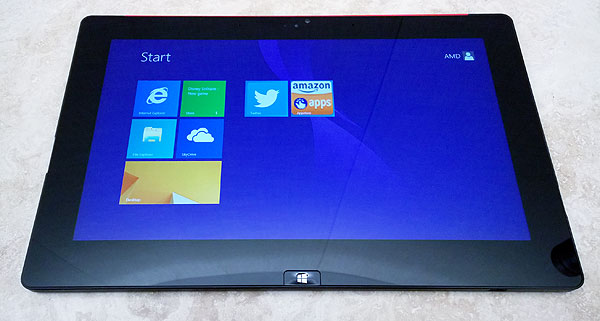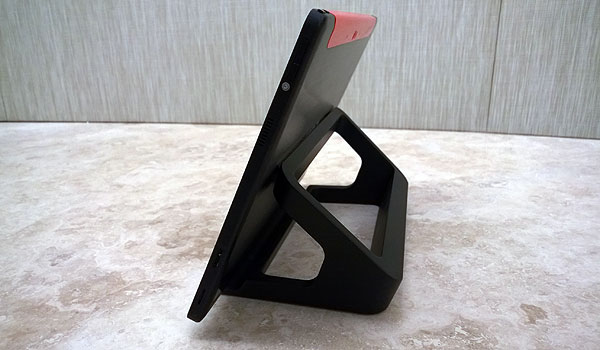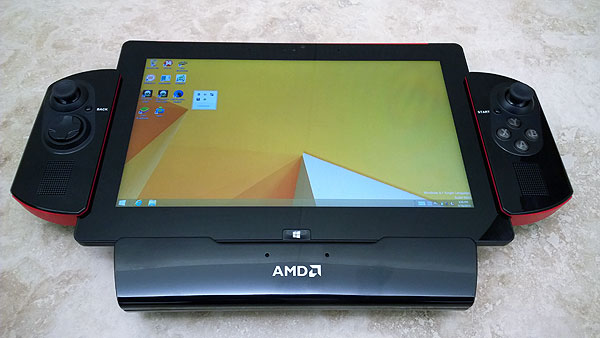Mullins And Beema APUs: AMD Gets Serious About Tablet SoCs
AMD recently introduced us to its Mullins and Beema APUs, which are architecturally similar to Kabini and Temash, but include some power and performance enhancements. We take an early look at a custom form factor and compare to Intel's best effort.
The Discovery Platform
While AMD doesn't provide a true reference platform for its new APUs, the company did have its engineers put together a functional test bed for demonstration purposes. Dubbed the Discovery project, we got to try out the platform at AMD's campus in Austin, Texas.
Equipped with the 4.5 W A10 Micro-6700T flagship, based on the Mullins APU, AMD's Discovery tablet is equipped with 2 GB of DDR3L-1333 inside a generic 10" display form factor. AMD showed off stylized peripherals alongside the device, such as a game controller attachment and dock, and demonstrated the platform wirelessly broadcasting video to a television.
Although it's interesting, Discovery isn't a shipping product. So, the tablet's most important job is simply showing that Mullins operates in a handheld chassis without thermal issues.
Discovery also gave us a sneak peek at the platform's performance capabilities. Naturally, we prefer to put retail hardware through its paces in our lab. However, AMD only has a handful of these things, and there aren't enough to send out to reviewers.
As a result, we were limited to a few hours of testing on-site at AMD. To the company's credit, we were given completely unrestricted access to the hardware and were allowed to install anything we wanted. Still, though, this is a one-off device benchmarked at AMD. There's no way for us to guarantee its clock rates or the amount of time it was able to sustain them represents anything you'll see in the future.
Typically it takes us days of testing to come up with truly useful data. But form factors are so important to tablet benchmarking that going deep into a demo platform would yield limited information anyway. I'd much rather put a commercially available product through the wringer, and that's what I'll do as soon as it's possible. Until then, the few numbers gleaned from AMD's Discovery will hopefully shed some light on the potential of AMD's newest APUs.
Even though I didn't have much time to test, I prepared a couple of interesting comparisons. For instance, I benchmarked Dell's Venue 8 Pro tablet equipped with an Atom Z3740D, giving us representation from Intel's low-power Bay Trail line-up. To better plot where Mullins falls on the spectrum, I also have the Celeron J1900 (Bay Trail-D) and Athlon 5350 (Kabini) in my charts. Those two processors are rated at higher 10 and 25 W TDPs, respectively.
Get Tom's Hardware's best news and in-depth reviews, straight to your inbox.
Current page: The Discovery Platform
Prev Page The Platform Security Processor, APU Models, And Market Positioning Next Page Synthetic BenchmarksDon Woligroski was a former senior hardware editor for Tom's Hardware. He has covered a wide range of PC hardware topics, including CPUs, GPUs, system building, and emerging technologies.
-
Nintendo Maniac 64 ...yeah, I don't think intending to benchmark full-on PC games that aren't even a year old on what is essentially a tablet APU was one of the wisest decisions you guys have made.Reply -
cleeve Reply13193339 said:...yeah, I don't think intending to benchmark full-on PC games that aren't even a year old on what is essentially a tablet APU was one of the wisest decisions you guys have made.
Actually, both Dota2 and Grid2 are well known for having low system requirements, and they represented a great opportunity to compare results to the desktop bay trail and kabini platforms. We would have tested these games regardless, but we would have added more, less demanding titles if we had more time.
-
Nintendo Maniac 64 Hmmm, sounds like an AMD equivalent of an Intel "tick", especially considering that the IPC between Puma+ and Jaguar is unchanged.Reply
Interestingly enough, this would mean that the PS4 and Xbone could use Puma+ cores in the future (with turbo disabled obviously).
-
PreferLinux OK, so where are the power measurements? That is about the most important part of the chip, and is also the part that is missing.Reply -
kyuuketsuki I'm not sure why you decided to benchmark Dota at 1920x1080 instead of 1200x800. You lost the ability to compare against the Venue 8 Pro *and* the results might have been something resembling playable. I'm always of the opinion that game benchmarking should focus around what the product in question (and its competitors) can actually, y'know, play. Seeing graphs of everything being in a range of 1-10 FPS just isn't interesting or particularly useful.Reply
But yeah, I understand the limited time and environment, and the look at Beema and Mullins is greatly appreciated. I'm *still* looking forward to a commercially-available tablet with an AMD SoC in it, since one never materialized with Temash. That Vizio tablet that used AMD was actually pretty nifty, except for using the Z-60(?) which just wasn't up to scratch. It's too bad Vizio seems to be deprecating its tablet efforts, since an update of that tablet with Mullins in it would be worth looking at. -
NoClue_87 Dota2 is very cpu intensive. It's a shame Valve aint interested in suporting mantle for dota 2.Reply -
CaptainTom I seriously cannot wait when 5 years from now I can get mid-range PC gaming in a tablet... The future cannot come soon enough...Reply -
tigger888 HOW is the author of this article NOT amazed that the apu is pushing NEAR 30 frames per second! With the competition only having half... Who pays these guys to write articles..Reply -
de5_Roy looks quite promising. these socs will be in media consumption devices, so i hope you'll include various media playback benches in the review.Reply
the tskin temp and tjmax temp look a bit low for outside use. i wonder if it'll be enough to prevent throttling in actual devices. -
cleeve Reply13193593 said:HOW is the author of this article NOT amazed that the apu is pushing NEAR 30 frames per second! With the competition only having half... Who pays these guys to write articles..
How did you not read the commentary, yet decide comment on it?
The article is very complimentary to the new APU's game performance. What exactly did you expect? Did you want me to write that its the "SUPERBEST GAMING APU EVAR"?


